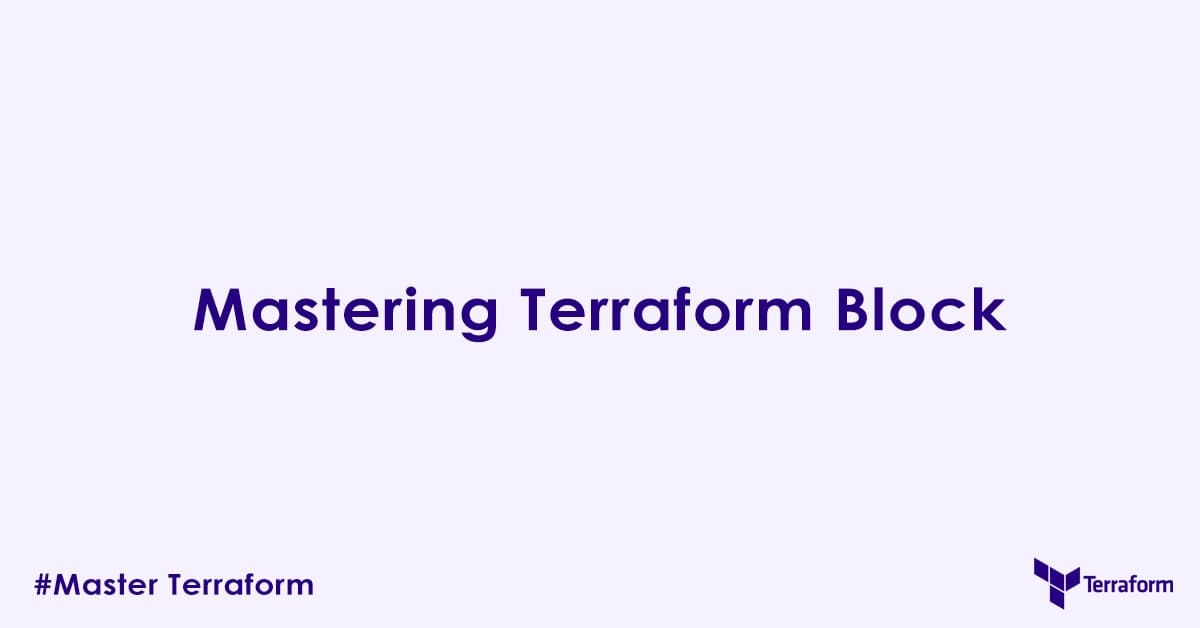In today’s blog post, we will learn terraform block used to define some critical terraform configurations like backends, terraform and provider versions etc. When you open a Terraform configuration file (.tf), one of the first and most fundamental blocks you will encounter is often the terraform block. While it does not directly define your infrastructure resources, the terraform block is very important. It is where you tell Terraform where to store your state files, which terraform version to use, what provider and provider version to use to manage your infrastructure.
What is the terraform Block?
The terraform block is a top-level configuration block that provides settings for Terraform’s core behavior. It acts as a configuration interface for the Terraform CLI itself, rather than for your cloud providers. You’ll typically find it at the beginning of your root module’s configuration file (e.g., main.tf or versions.tf).
Think of it as the “meta-configuration” for your Terraform project.
Why is the terraform Block So Important?
- Version Compatibility: It enforces which Terraform CLI versions can run your configuration, preventing unexpected behavior from newer/older CLI versions.
- Provider Management: It declares which providers your configuration depends on and specifies their required versions, ensuring consistency across environments and team members.
- State Management: It defines how and where Terraform stores its state file.
- CLI Features: It can enable experimental features or integrate with HashiCorp Cloud Platform (HCP) Terraform.
Key Arguments of the terraform Block
The terraform block contains several nested arguments and blocks that define its behavior:
required_version (String)
This argument specifies the compatible versions of the Terraform CLI that can be used to apply this configuration. It’s highly recommended to use version constraints to prevent unexpected behavior from newer (or older) Terraform versions that might introduce breaking changes.
terraform {
required_version = ">= 1.5.0, < 2.0.0" # Example: compatible with 1.5.0 and above, but not 2.0.0
}Common Version Constraint Operators:
=(exact version):1.5.0!=(not equal to):!= 1.5.0>(greater than):> 1.5.0<(less than):< 1.5.0>=(greater than or equal to):>= 1.5.0<=(less than or equal to):<= 1.5.0~>(pessimistic constraint / “patch level”):~> 1.5means1.5.x(any patch version of 1.5), and~> 1.5.0means1.5.0,1.5.1, etc., but not1.6.0. This is the most common and recommended operator for stability.
Explanation: If your local Terraform CLI version doesn’t satisfy this constraint, terraform init will fail, forcing you to use a compatible version. This is important for terraform code consistency and preventing unexpected behavior due to CLI updates.
required_providers (Block)
This block declares all the providers that your configuration uses and specifies their version constraints. This is essential for terraform init to download the correct provider plugins.
terraform {
required_providers {
aws = {
source = "hashicorp/aws" # Official HashiCorp provider
version = "~> 5.0" # Compatible with AWS provider v5.x
}
azurerm = {
source = "hashicorp/azurerm"
version = ">= 3.0.0, < 4.0.0" # Compatible with Azure provider v3.x
}
local = {
source = "hashicorp/local" # A common utility provider
version = "~> 2.0"
}
# You can also specify community/third-party providers
# foo = {
# source = "registry.terraform.io/community/foo"
# version = "1.2.3"
# }
}
}Arguments within required_providers:
source: (Required) The address of the provider’s source code in the Terraform Registry. For official HashiCorp providers, it’s typicallyhashicorp/<PROVIDER_NAME>. For community providers, it includes the namespace (e.g.,community/foo).version: (Required) The version constraint for the provider plugin. This uses the same version constraint syntax asrequired_version.
Explanation: When you run terraform init, Terraform reads this block, downloads the specified provider versions, and stores them in your .terraform directory. This ensures everyone working on the project uses the exact same provider versions, preventing subtle differences in resource behavior.
backend (Block)
This nested block defines how and where Terraform stores its state file (terraform.tfstate). As discussed in “Mastering Terraform Backend Block,” using a remote backend is essential for teams and production environments for collaboration, state locking, and durability.
terraform {
# ... (required_version, required_providers) ...
backend "s3" { # Using the AWS S3 backend
bucket = "my-app-tfstate-bucket-unique" # Must be globally unique
key = "environments/prod/my-app.tfstate" # Path within the bucket
region = "us-east-1"
encrypt = true # Encrypt state at rest
dynamodb_table = "my-app-tf-locks" # For state locking
acl = "private"
}
# Or an Azure backend:
# backend "azurerm" {
# resource_group_name = "tfstate_rg"
# storage_account_name = "tfstateaccount"
# container_name = "tfstate"
# key = "prod/my-app.tfstate"
# }
}Arguments within backend: The arguments within the backend block are specific to the chosen backend type (e.g., bucket, key, region for S3; resource_group_name, storage_account_name for azurerm).
Explanation: The backend block instructs terraform init to configure remote state. If you change backend configuration after initialization, you will need to run terraform init -migrate-state to safely migrate your state to the new location.
cloud (Block – for HCP Terraform Integration)
This block configures integration with HashiCorp Cloud Platform (HCP) (formerly Terraform Cloud) with Terraform. It allows you to specify the organization and optionally a workspace to use for remote operations.
terraform {
# ... (required_version, required_providers) ...
cloud {
organization = "my-hcp-org"
# Optional: If you want to default to a specific workspace for runs
# (can be overridden by TF_WORKSPACE environment variable or CLI flags)
# workspace {
# name = "my-prod-workspace"
# }
}
}Explanation: This simplifies running Terraform operations directly within HCP Terraform’s run environment, centralizing state management, collaboration, and remote execution. It supersedes the backend "remote" configuration.
experiments (Set of Strings – for Experimental Features)
This argument allows you to opt-in to experimental Terraform CLI features that are not yet stable. These features are subject to change or removal without notice and should be used with caution, ideally not in production.
terraform {
# ...
experiments = [variable_defaults_for_outputs] # Example of an experimental feature flag
}Explanation: This is for power users and those testing new features. Always refer to the Terraform documentation for the latest experimental features and their implications. And do not use experiments in your production environment unless you are fully aware of what you are doing.
Best Practices for the terraform Block
- Always Define
required_versionandrequired_providers: This is fundamental for project stability and team consistency. Use pessimistic constraints (~>) for both to allow for patch and minor updates without breaking changes. - Separate
terraformBlock: It’s common practice to put theterraformblock (especiallyrequired_version,required_providers, andbackend) in a dedicated file, often namedversions.tformain.tf, at the root of your configuration. - Consistency Across Modules: While child modules also have
required_providersblocks, their constraints should ideally be compatible with or stricter than the root module’s. The root module’srequired_providersare what ultimately determine which provider versions are downloaded for the entire configuration. - Backend Configuration at Root: The
backendconfiguration should only appear in your root module’sterraformblock. Child modules do not and should not define their own backends. terraform initis Key: Remember that changes to theterraformblock (especiallybackendandrequired_providers) require you to runterraform initagain to re-initialize the working directory, download new provider versions, or migrate state.- Avoid Over-Constraint: Do not pin to exact versions unless absolutely necessary (e.g.,
version = "1.5.0"). This makes upgrades difficult. The~>operator is usually the safest balance.
Conclusion
Though often overlooked, the terraform block is one of the most critical block in your terraform configuration. Used to define how terraform manages its state file, which terraform version to use, what providers to use and what provider version to use.
Author

Experienced Cloud & DevOps Engineer with hands-on experience in AWS, GCP, Terraform, Ansible, ELK, Docker, Git, GitLab, Python, PowerShell, Shell, and theoretical knowledge on Azure, Kubernetes & Jenkins.
In my free time, I write blogs on ckdbtech.com
